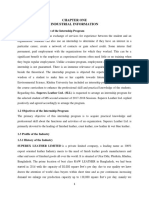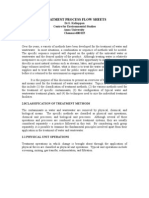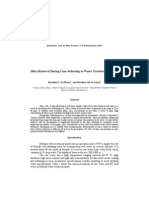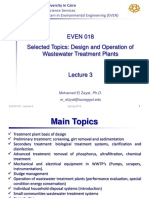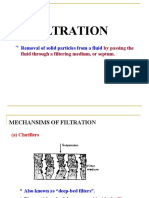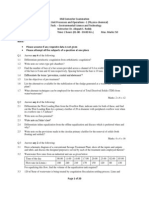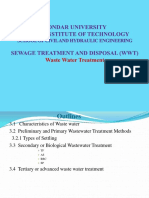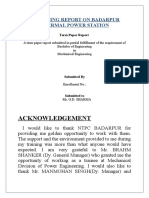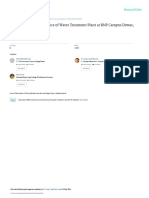100%(1)100% found this document useful (1 vote)
119 viewsFiltration Process Troubleshooting
This document outlines potential triggers, actions, and process changes to troubleshoot filtration process problems. Triggers include changes in water quality parameters, clarification process quality, and filtration problems. Possible actions include analyzing water quality, assessing overall performance, jar testing, and verifying doses. Possible process changes include adjusting coagulant dosage, mixing intensity, sludge removal frequency, filtration rate, and backwash cycle. The goal is to identify triggers, take corrective actions, and implement targeted process changes to resolve issues with turbidity, color, pH, or chlorine demand in the filter outflow.
Uploaded by
Firdaus YahyaCopyright
© © All Rights Reserved
Available Formats
Download as DOCX, PDF, TXT or read online on Scribd
100%(1)100% found this document useful (1 vote)
119 viewsFiltration Process Troubleshooting
This document outlines potential triggers, actions, and process changes to troubleshoot filtration process problems. Triggers include changes in water quality parameters, clarification process quality, and filtration problems. Possible actions include analyzing water quality, assessing overall performance, jar testing, and verifying doses. Possible process changes include adjusting coagulant dosage, mixing intensity, sludge removal frequency, filtration rate, and backwash cycle. The goal is to identify triggers, take corrective actions, and implement targeted process changes to resolve issues with turbidity, color, pH, or chlorine demand in the filter outflow.
Uploaded by
Firdaus YahyaCopyright
© © All Rights Reserved
Available Formats
Download as DOCX, PDF, TXT or read online on Scribd
You are on page 1/ 2
FILTRATION PROCESS TROUBLESHOOTING
Trigger Possible Actions Possible Process
Changes
Sources Water Quality Changes
Changes in : Perform necessary analysis Adjust coagulant dosage.
Turbidity Asses overall process performance Adjust mixer/flocculator mixing intensity.
Colour Perform jar test Change frequency of sludge removal
pH Increase frequency of monitoring (increase or decrease)
Temperature Verify responses to process changes Change filtration rate (add or delete filters)
Alkalinity Add lime or caustic soda if alkalinity is low. Adjust backwash cycle. (rate, duration)
Chlorine demand
Clarification Process Quality Changes
Changes in : Asses overall performance. Adjust coagulant dosage.
Turbidity or floc carryover Perform jar test. Adjust mixer/flocculator mixing intensity.
Metal ion residual carryover. Check that selected chemical doses are being Change frequency of sludge removal
applied. (increase or decrease)
Change filtration rate (add or delete filters)
Adjust backwash cycle. (rate, duration)
Filtration Problem
Changes resulting in : Asses overall performance. Adjust coagulant dosage.
Head loss increase Perform jar test. Adjust mixer/flocculator mixing intensity.
Short filter runs Verify responses to process changes Change frequency of sludge removal
Media surface sealing Manually remove mudballs. (increase or decrease)
Mudballs Replenish loss media Decrease filtration rate
Filter media cracks, shrinkage Check head loss indicator for correct Adjust backwash cycle. (rate, duration)
Filter will not clean operations.
Media loss
Excessive head loss
Filter Outflow Quality Changes
Changes resulting in : Asses overall performance. Adjust coagulant dosage.
Turbidity breakthrough Perform jar test. Adjust mixer/flocculator mixing intensity.
Color Verify process performance. Change frequency of sludge removal
pH a) Coagulation-flocculation process (increase or decrease)
Chlorine demand b) Clarification process Decrease filtration rate
c) Filtration process Change chlorine dosage.
Verify response to process changes at
appropriate time.
You might also like
- Íïïjè.55Oî Í8uRE&) Î: Mohamad Firdaus Bin YahyaNo ratings yetÍïïjè.55Oî Í8uRE&) Î: Mohamad Firdaus Bin Yahya14 pages
- CHBE 241 (2020W1) (Material & Energy Balances) Assignment 02No ratings yetCHBE 241 (2020W1) (Material & Energy Balances) Assignment 024 pages
- Blondal M Series - Service Manual Version 1 8No ratings yetBlondal M Series - Service Manual Version 1 834 pages
- BT 0413 BioseparationTechnologyLaboratoryNo ratings yetBT 0413 BioseparationTechnologyLaboratory21 pages
- Chapter One Industrial Information: 1.1 Background and Scope of The Internship ProgramNo ratings yetChapter One Industrial Information: 1.1 Background and Scope of The Internship Program12 pages
- Water Treatment Plant Performance Evaluations and OperationsFrom EverandWater Treatment Plant Performance Evaluations and OperationsNo ratings yet
- Design Manual Removal of Arsenic From DRNo ratings yetDesign Manual Removal of Arsenic From DR78 pages
- Determination of The Volume of Flow Equalization Basin in Wastewater Treatment SystemNo ratings yetDetermination of The Volume of Flow Equalization Basin in Wastewater Treatment System9 pages
- 21810, Ultrapure Water Breakpoint CL andNo ratings yet21810, Ultrapure Water Breakpoint CL and5 pages
- Flow Diagram of A Conventional Potable Water Treatment Plant2No ratings yetFlow Diagram of A Conventional Potable Water Treatment Plant221 pages
- Hydro-Flo Technologies, Inc.: Chemical Name Acid - Typical Project Name XX-XXXXNo ratings yetHydro-Flo Technologies, Inc.: Chemical Name Acid - Typical Project Name XX-XXXX4 pages
- 19.2. Dewatering of Sludge by FiltrationNo ratings yet19.2. Dewatering of Sludge by Filtration46 pages
- Full Download Efficiency in Wastewater Treatment in North America A Compendium of Best Practices and Case Studies of Novel Approaches 1st Edition George Crawford PDF DOCX100% (9)Full Download Efficiency in Wastewater Treatment in North America A Compendium of Best Practices and Case Studies of Novel Approaches 1st Edition George Crawford PDF DOCX67 pages
- Modeling of Activated Sludge With ASM1 Model, Case Study On Wastewater Treatment Plant of South of IsfahanNo ratings yetModeling of Activated Sludge With ASM1 Model, Case Study On Wastewater Treatment Plant of South of Isfahan10 pages
- Treatment Processes: Coagulation and Filtration: Draft Guidelines For Drinking-Water QualityNo ratings yetTreatment Processes: Coagulation and Filtration: Draft Guidelines For Drinking-Water Quality25 pages
- Critical Review of Desalination ConcentrNo ratings yetCritical Review of Desalination Concentr13 pages
- Silica Removal During Lime Softening in Water Treatment PlantNo ratings yetSilica Removal During Lime Softening in Water Treatment Plant10 pages
- Group 1 - Section 01G - Separation Project PDFNo ratings yetGroup 1 - Section 01G - Separation Project PDF46 pages
- Actiflo Process For Drinking Water TreatmentNo ratings yetActiflo Process For Drinking Water Treatment6 pages
- Chapter 5 (Part 1) Secondary Treatment (Biological)100% (2)Chapter 5 (Part 1) Secondary Treatment (Biological)76 pages
- UPO-1: Unit Processes and Operations (Physico-Chemical) - Question Papers100% (2)UPO-1: Unit Processes and Operations (Physico-Chemical) - Question Papers20 pages
- Wastewater Characteristics Physical ChemicalNo ratings yetWastewater Characteristics Physical Chemical31 pages
- Ion Exchange Report - Group 4 Section 2No ratings yetIon Exchange Report - Group 4 Section 218 pages
- CCB 3062 Unit Operation Lab Ii Experiment 5: CSTR: TH RDNo ratings yetCCB 3062 Unit Operation Lab Ii Experiment 5: CSTR: TH RD14 pages
- 1) (15 PTS) A 10 Inch Diameter Sanitary Sewer Is Designed Such That It100% (1)1) (15 PTS) A 10 Inch Diameter Sanitary Sewer Is Designed Such That It13 pages
- Water Desalination 2016/2017: For 3 Grade, Mechanical Power EngineeringNo ratings yetWater Desalination 2016/2017: For 3 Grade, Mechanical Power Engineering7 pages
- Operate and Report On A Water Treatment Plant100% (1)Operate and Report On A Water Treatment Plant3 pages
- Far560 Financial Accounting and Reporting 4 Test 1No ratings yetFar560 Financial Accounting and Reporting 4 Test 12 pages
- Ice Breaking AIS655 OCT2020: Ir DR Mohd Badrulhisham IsmailNo ratings yetIce Breaking AIS655 OCT2020: Ir DR Mohd Badrulhisham Ismail10 pages
- AA LESSON PLAN AIS655 - OCT 2020 - Student - Update18oct2020No ratings yetAA LESSON PLAN AIS655 - OCT 2020 - Student - Update18oct20203 pages
- Fabric Ducting & Diffusers: English VersionNo ratings yetFabric Ducting & Diffusers: English Version6 pages
- Jargeous - Product - Catalog Ver 1220 Compressed PDFNo ratings yetJargeous - Product - Catalog Ver 1220 Compressed PDF16 pages
- Transport Processes and Unit Operations Geankoplis PDFNo ratings yetTransport Processes and Unit Operations Geankoplis PDF1 page
- Technical Bulletin 517 - Total Alkalinity Measurement in Natural WatersNo ratings yetTechnical Bulletin 517 - Total Alkalinity Measurement in Natural Waters4 pages
- Wastewater Engineering Treatment 5th Edition Solutions ManualNo ratings yetWastewater Engineering Treatment 5th Edition Solutions Manual19 pages
- The Issue of Wastewater Is Becoming More and MoreNo ratings yetThe Issue of Wastewater Is Becoming More and More11 pages
- Enhancement of Curcumin's Anti-Psoriatic Efficacy Via Formulation Into Tea Tree Oil-Based EmulgelNo ratings yetEnhancement of Curcumin's Anti-Psoriatic Efficacy Via Formulation Into Tea Tree Oil-Based Emulgel15 pages
- Operation and Maintenance of Water Treatment Plant at BNP Campus Dewas, India: A Case StudyNo ratings yetOperation and Maintenance of Water Treatment Plant at BNP Campus Dewas, India: A Case Study5 pages
- Refinery Wastewater Management Using Multiple Angle Oil Water Separators PDFNo ratings yetRefinery Wastewater Management Using Multiple Angle Oil Water Separators PDF24 pages
- Biocoagulant: For Waste Water Treatment: January 2012No ratings yetBiocoagulant: For Waste Water Treatment: January 20129 pages
- Algal Alginate - A Potential Coagulant For Drinking Water TreatmentNo ratings yetAlgal Alginate - A Potential Coagulant For Drinking Water Treatment6 pages
- How Mixing Affects The Rheology of Refractory Castables - Part IINo ratings yetHow Mixing Affects The Rheology of Refractory Castables - Part II25 pages
- Topic 1 - Drilling Problems & Solutions NotesNo ratings yetTopic 1 - Drilling Problems & Solutions Notes30 pages






